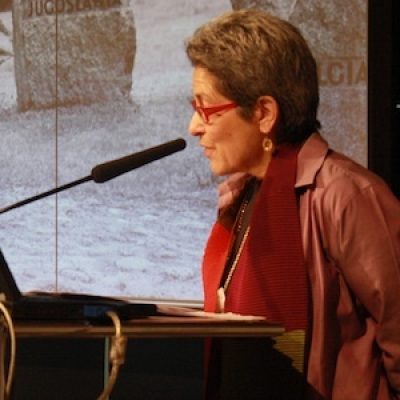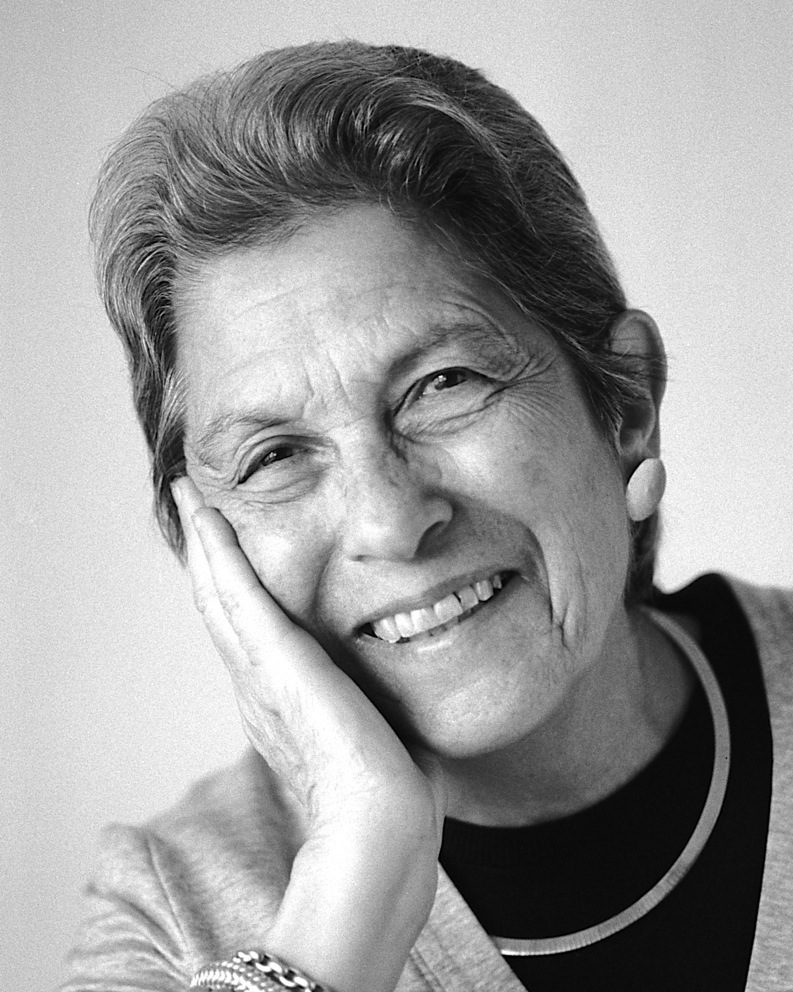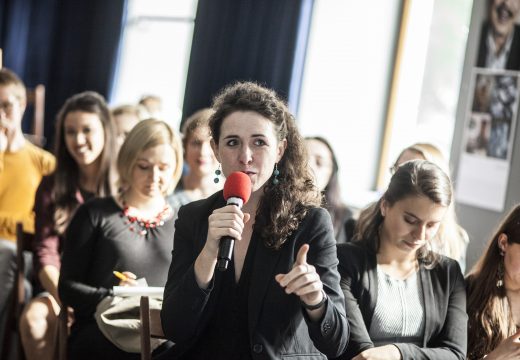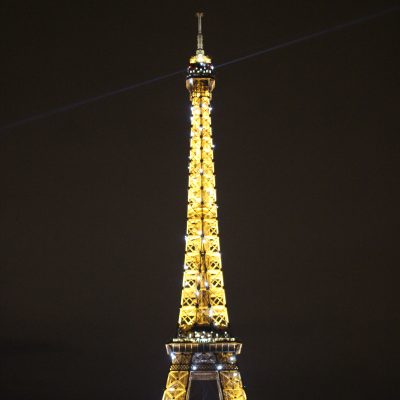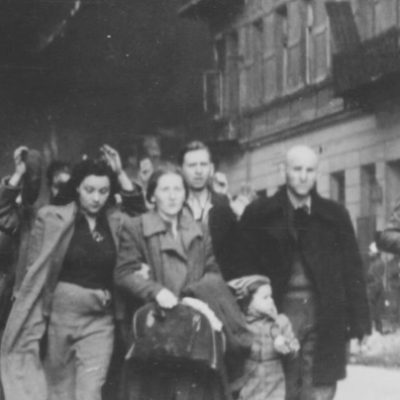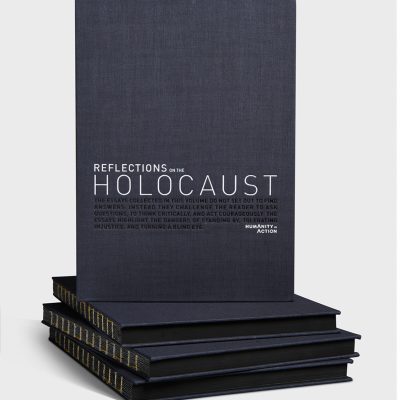Details
Contributors
Speaker
Judith Goldstein
Date
26 Oktober 2019
Location
Berlin, Germany
Event
Time to Act: Addressing Antisemitism in our Societies
Country
Article
Speech delivered at the Humanity in Action Conference in Berlin, October 2019, by Judith S. Goldstein
I must admit that I find Antisemitism mystifying. Be assured that I recognize that this is not a particularly instructive way to speak at this important conference. I have no doubt that we could spend days, months and years studying this critical issue. There are thousands of books, centers, institutes, organizations and foundations, such as the German Foundation “Remembrance, Responsibility and Future” (EVZ), that work to beat back the scourge. There are also too many others that promote the dark and poisonous view of the Jewish people. The topic is alive and well as it has been for centuries or millennia. That is why we are here with the support of the Foundation EVZ.
What I find baffling is the persistence of Antisemitism. This concern is the case for many individual Jews in the diaspora who are part of a particular society; it is also true for Jews gathered in the state of Israel, which is part of the international world of nation states. This phenomenon of group-focused hostility toward Jews seems to have a life of its own irrespective of time or place. Antisemitism does not need the presence of Jews or Jewish life to unfold within a society. It is a curse without boundaries or end.
In the DNA of human history that pits tribe against tribe, Jews are continually identified as a separate and dangerous people. This is a paranoid’s delight because there is much history to support the view that Antisemitism is endemic and unquenchable.
It can be viewed as a social virus that lies dormant in human society until it emerges as a raging disease. In the DNA of human history that pits tribe against tribe, Jews are continually identified as a separate and dangerous people. This is a paranoid’s delight because there is much history to support the view that Antisemitism is endemic and unquenchable. This idea, which is often used in engaging the subject of Antisemitism, requires some clarification. The DNA, I believe, is not the social/psychological/cultural code for Antisemitism. It is, instead, a human code for requiring an enemy that rests upon a powerful and deeply established narrative.
This is true for both parties engaged in the tensions of acceptance or enmity. For Jews, the fear of destruction doesn’t only come from outside the community. The Bible contains numerous warnings such as when Moses speaks to the people as they are about to leave the desert and enter Israel. They will suffer grievously, he says, when they break away from the commands of the Covenant between them and God. The Lord tells Moses: “Then My anger will flare up against them, and I will abandon them and hide my countenance from them. They shall be ready prey and many evils and troubles shall befall them.” (Deuteronomy 31:17.) But Jews were hardly prepared for centuries of suspicions and violence or for the most extreme explosions when Antisemitism broke out in Germany and gained lethal force through the Shoah in Europe.
Jews were hardly prepared for centuries of suspicions and violence or for the most extreme explosions when Antisemitism broke out in Germany and gained lethal force through the Shoah in Europe.
In trying to understand the longevity of this social disease let me present a paradigm that is actually a conundrum. This is an attempt to explain, but only in part, why Jews are viewed as a continuing challenge for societies, particularly in the Western world and the Middle East. The model is based on the idea that Jews have functioned in a no man’s land of transitioning between being included and excluded in a particular society, culture, nation or empire. In riding a dangerous roller coaster of disruptive confusion as both insiders and outsiders, Jews have participated in some of the most critical developments in the past two millennia. When excluded they were treated with contempt as foreign and dangerous. When traveling beyond an insular Jewish world through mobility, integration and/or assimilation, they were seen as a threat and destabilizing force to the worlds they entered.
When excluded Jews were treated with contempt as foreign and dangerous. When traveling beyond an insular Jewish world through mobility, integration and/or assimilation, they were seen as a threat and destabilizing force to the worlds they entered.
This conceptual approach of inside/outside is lifted or stolen from the title and major theme of a book by Herman Wouk, a US-American writer of some distinction and great success in the mid to late 20th century. His Jewish family came from Russia, emigrated to the United States and started down the shaky path to acceptance and integration in America’s Christian dominated society. They remained observant Jews, threading their religious practices and distinct culture into their endeavors to thrive financially, educationally and culturally. They were proudly insular and distinctly Jewish in retaining their forms of religious observance, customs and language and, in Wouk’s telling, highly neurotic and hilarious behaviors. In their 20th century of rising expectations for immigrants and America’s power, they hoped that they could be both American and Jewish by incorporating the best of their two worlds.
This was part of the United States’ singular and magical mythology: Jews could remain both inside a Jewish culture and religion, nurtured in Europe and the Middle East, as they sought to move outside into larger non-Jewish societies. Thus the dynamic of irreconcilable forces and tensions in the inside/outside concept that Wouk invoked: the outside American Christian society presented fabulous promises as well as threats to the insular Jewish world of religion and culture. The Christian world regarded Jews and their formidable accomplishments of mobility—moving inside the Christian and sectarian worlds fulfilling America’s aspirational ideas of equality—as threatening to the established religious values, social and economic order and culture.
Working from Wouk’s America saga let me provide a few historic examples. If one looks back 2,000 years, Christianity is the first place to begin. The birth and development of a derivative, competitive and vibrant Christian religion, removed Jews from being inside—with their special connection to one god—to an outside people and religion. They were inside as the authors of a monotheistic belief system with the promise of divine intervention and redemption. They were cast outside or put themselves outside by failing to follow the beliefs of a new and powerful religious force. Jews were judged as the people who caused the betrayal, suffering and death of the new messiah—all essential foundations of Christology. The message was incorporated in a powerful and long-enduring liturgy: in written narratives and through pictorial and sculptured images in churches and other closely intertwined religious and political institutions.
In the contest for revealing the word of God and finding adherents, Christianity was overwhelmingly triumphant. Within the combined world of church and state, the Jews were habitually depicted as traitors and devils in the Christian world. Perceived as the enemy, over many centuries Christian countries and empires prohibited Jews from mixing with non-Jews in political, economic and social realms. Since their religion was not recognized as legitimate or equal to Christianity, Jews experienced deep discrimination and were treated as inferior, non-citizens and non-beings. The range of restrictions is nearly encyclopedic. Expulsions were one extreme. Jews were forced to leave large and small countries such as, for example, England in 1290—a dictate that lasted for 300 years, Spain in the 1490s or Norway in 1687. In a more limited way, in Italy for example, Jews were segregated in ghettos and locked behind gates in the night. Only in the mid-19th Century were Italian Jews allowed to enter public schools and become citizens.
When eventually invited to enter a country, civil and political rights were often subject to restrictions on Jews in regard to occupations they could pursue, places where they could live and even the clothing they could wear. Berlin, for example, controlled the presence of Jews, especially Jewish peddlers, through taxes and restricted stays. The arrival of Moses Mendelssohn from Dessau is a stunning example. “In the fall of 1743,” Amos Elon wrote in The Pity of it All: A History of Jews in Germany, 1743-1933, “a fourteen-year-old boy entered Berlin at the Rosenthaler Tor, the only gate in the city wall through which Jews (and cattle) were allowed to pass.” (p.1) He had little, if any, money, and was frail from malnutrition. He was interrogated closely. He could have been taxed in ways similar to that on Polish oxen. Alon wrote that the gatekeeper’s task was to “stop and register all incoming Jews, keep an eye on them during their stay, and expel the foreign ones’ as soon as possible.” The record for the day listed the following entries: “six oxen, seven swine and a Jew.” (Amos Elon, The Pity of it All: A History of Jews in Germany, 1743-1933, p.2)
Mendelssohn was a quintessential outsider, from a deeply insular and densely populated 18th Century Jewish Polish religious culture. Driven by his intellect and ambition, he sought entry into the world of German enlightened thought. He not only passed through the actual Berlin gates but eventually through the cultural gates of the burgeoning world of the Enlightenment. When Frederick II loosened the grip of religious thought and power, Mendelssohn stayed in Berlin and became one of the great Jewish religious philosophers and recognized leaders of the Enlightenment.
For centuries Jews were barred from land holdings of any consequence, excluded from practicing certain crafts and powerful guilds. They were, however, employed as non-Christian moneylenders, the Shylocks so to speak.
He also became immensely wealthy, partaking of the dynamic capitalistic and industrial transformation in Europe in the 18th and 19th Centuries. In simplistic terms, capitalism enabled immense profit from finance and industry—skills in investing money in other than dynastic landed wealth—and the accumulation of new forms of wealth.
For centuries Jews were barred from land holdings of any consequence, excluded from practicing certain crafts and powerful guilds. They were, however, employed as non-Christian moneylenders, the Shylocks so to speak.
They were thus positioned to plunge into the new worlds of trade, finance, industrialization and communications. In the transition from one type of traditional wealth and aristocracy, Jews became a maligned locus and focus of instability. “The new capitalistic economy,” Elyse Wien observed, “was identified with greed, corruption and mysterious manipulations versus ordained wealth and landed hierarchical order. Thus, Jews were prevented from engaging in what natural law adherents called productive labor and then castigated and penalized for not participating in such fields. Confined only to hated professions, Jews were then hated for practicing those professions.” (Elyse Wien, When ‘Finance’ Becomes a Code Word for Jewish, 6 November 2019, tabletmag.com)
The economic changes accompanied new concepts about human behavior and governance: reason, individual rights, science and liberalism. These new ideas affected the exercise of power and hierarchy and the concepts of freedom and rights. They also resulted in new forms of inclusion. According to Yale historian David Sorkin, Emancipation was “the principal event of modern Jewish history.” First came privileges, then cascades of rights in an erratic pattern from country to country. For example, Jews gained legal equality in France in 1791 (for 40,000 Jews),in various Germany states through the 19th century and finally in all the German states in 1871. (Poland had been the exception since it had emancipated Jews in 1264 and welcomed more, especially after their expulsions from Spain.) Sorkin concluded that “the process of gaining and retaining, exercising and defending, losing and recovering rights has been at the heart of the Jews’ experience over the past four and half centuries. (David Sorkin, Jewish Emancipation: a History Across Five Centuries, p.354)
Theories of tolerance, freedom and promises of equality drove revolutions and wars. Various forms of representative and democratic government in service to the bourgeoisie replaced monarchies. While Enlightenment thinking gradually resulted in freedom for Jews, for millions of others the new concepts provided rationales for slavery and colonial domination. The new concepts about human beings were employed to justify European dominance over foreign lands and so-called barbarian peoples.
As Jews moved inside society and gained mobility, wealth and status, their advancement through finance and capitalism was viewed as dispossessing those who had held power and wealth in the past.
As Jews moved inside society and gained mobility, wealth and status, their advancement through finance and capitalism was viewed as dispossessing those who had held power and wealth in the past. Reactions were often fierce as they played out in political, economic and social terms. “The Jew,” Karl Marx observed in his essay “On the Jewish Question,” “has emancipated himself in a Jewish manner … because money has become a world power. … The Jews have emancipated themselves insofar as the Christians have become Jews.” Or in the inside/outside paradigm, one might observe that the Christians once again reverted back to being Jews! “In so far as Jewish people had found social or political acceptance,” Wien wrote in regard to Marx’s idea, “it was only because the world had become more perverse. The world was becoming one in which finance was less and less considered an unmentionable occupation for designated outcasts, than a standard, accepted profession.” Nonetheless, the force to push back and once again cast the Jews as outsiders gave birth to the term anti-Semitism, an invention of the German writer Wilhelm Marr in 1879. It attached a new name to the outburst of anti-Jewish political parties, newspapers and journals in Germany, the Hapsburg Empire and France.
A stunning example of the insider/outsider syndrome was revealed in the famous history of Captain Alfred Dreyfus, an assimilated French Jew and the only Jew of high rank in the French army. He had entered the holy sanctuary of belonging to protect the French nation. In 1894 Dreyfus was unjustly convicted of treason in league with the Germans, sent to Devils Island in French Guiana and subjected to a series of excruciating judicial inquiries until he was finally found innocent in 1906. Twelve years before, the army had stripped Dreyfus of his military position. He had to walk in the Paris courtyard of the Ecole Militaire, shamed and scorned before troops and the public that was invited to view a spectacle of humiliation and expulsion. A New York Herald reporter wrote the following description of the man, bereft his military emblems and sword: “No less the 20,000 people, who were kept at a distance from the scene, surrounded the square and hooted at the prisoner throughout the ceremony, shouting: Death to the traitor! Death to the Jews!” (Ralph Nurnberger, lecture on Zionism) For decades the Dreyfus affair traumatized France—its governments, military, press, public and Catholic Church—and was a cause “célèbre” in other Western countries.
The drama of public degradation was a striking example of the tensions involved in enabling Jews to enter the establishment and their subsequent expulsion to the outside world. For Jews throughout Europe and the United States, the Dreyfus Affair was a cataclysmic warning. While they had recently risen to become journalists, professors, lawyers, politicians, doctors and entrepreneurs, once inside societies, new forms of anti-Semitism undermined Jewish status and stability. Jews sought to adapt. Or in frustration, retreat and despair, they looked for radical alternatives to the evolving societal norms. The journalist and author Theodore Herzl followed the first course and then the second. An assimilated Viennese Jew and reporter, he went to France to cover the Dreyfus trial. The course of the trail caused Herzl to become obsessed with the “Jewish Question” and the belief that entry into society would not secure the viability of Jews. His answer was to abandon the outside world and entry into European societies by establishing a separate Jewish state. He embarked on a crusade. His hopes were so powerful and blindingly idealistic that he assumed that “the Jews, once settled in their own State, would probably have no more enemies.” (Adam Kirsch, The People and the Books 19 Classics of Jewish Literature, p. 332)
Americans feared massive migration of Jews and others from Eastern and Southern Europe in the aftermath of World War I. Thus they were added to the list of unwanted immigrants—a list that already included Chinese and Japanese immigrants.
The Zionist ideal to establish a Jewish state in Palestine appealed to millions of Jews in Eastern Europe. In fact, most fled in the opposite direction to America and Western European nations. That ever growing Jewish presence and mobility in the late 1800s and early 1900s simultaneously nurtured hopes of integration and freedom as well as suspicions and fears in the host societies. New iterations of Antisemitism morphed from the religious foundations of opposition into the pseudo-science of eugenics that classified people into superior and inferior races. Eugenicists imagined a race war in which superior Anglo Saxons and Aryans would be outpopulated by inferior races.
Americans feared massive migration of Jews and others from Eastern and Southern Europe in the aftermath of World War I. Thus they were added to the list of unwanted immigrants—a list that already included Chinese and Japanese immigrants.
The United States feared massive immigration of Jews and others from Eastern and Southern Europe in the aftermath of World War I. Thus they were added to the list of unwanted immigrants—a list that had already included Chinese and Japanese immigrants. In 1924, the United States Congress reversed its tradition of open immigration. Antisemitic forces effectively locked out millions of outsiders who suffered persecution especially in Poland and other Eastern European countries. The same American antisemitic animus simultaneously restricted Jews from living in numerous residential areas, working in prestigious professions, gaining employment in corporations and certain industries, accessing hotels, resorts, prestigious clubs and organizations. Segregation in fact.
Nazi ideology rested on the presumed dangers from Jews inside the Christian/Aryan world who were cast as deadly germs infecting the politics, culture, health and economic well being of German and then European society. Thus the brutal campaign to strip Jews, first in Germany and then in conquered European countries during World War II, of their assets, homes and occupations.
It was in Germany, however, that the conversion from insider to outsider became the most dramatic and deadly. As summarized by Robert M. Seltzer in Jewish People, Jewish Thought: The Jewish Experience in History, “…anti-Semitic ideologists asserted that the ‘Semitic mentality’ was egotistic, materialistic, skillful in trading and finance, deficient in physical courage, and lacking the ability to be culturally creative; in contrast, the ‘Aryan mentality,’ was life-affirming, heroic, and possessed of a vivid poetic imagination.” (Jewish People, Jewish Thought: The Jewish Experience in History, p. 633) Nazi ideology rested on the presumed dangers from Jews inside the Christian/Aryan world who were cast as deadly germs infecting the politics, culture, health and economic well being of German and then European society. Thus the brutal campaign to strip Jews, first in Germany and then in conquered European countries during World War II, of their assets, homes and occupations. When none of these assaults satisfied the Nazis thirst for persecuting Jews, they were thrust outside of humanity. Jews were perceived and treated as non-human—to be quashed and wiped out—and in the final frenzy of violence through starvation, forced labor, bullets and poisoned gas in death factories.
Every place but Denmark! Jewish life was different in that small country under occupation. A model protectorate according to the Germans from 1940 to 1943, the Allies recognized it as a collaborating country. And yet approximately 7,500 Jews in Denmark found protection through the Danish government and public, which embraced them as Danes with full and enduring rights to life and and property.
The Jews were embedded inside the culture and state even when the Germans in the fall of 1943 sought to rip them out. The Danes engaged in resistance that enabled all but 450 Jews to escape to Sweden. The Danes took responsibility for those Jews who were captured and sent out of the country to Theresienstadt. By sending packages of food, vitamins and clothing, the Danes kept alive all but 50 of those who were sent East into the death camps. Pursued by the Germans as part of the Holocaust, the Danish Jews became the symbol of Danish resistance after years of accommodations to the Germans. When the war ended, Jews were welcomed back to Denmark—to return to their lives inside the country. Sustained by trust in its liberal Christian values, Denmark enabled its Jews to survive.
Denmark, however, was the sole exception as the war forced Jews outside of life and Europe. Although the Allies defeated the German Nazi state and looked to a new world of democratic dominance and adherence to human rights, Jews went inside—into the fulfilment of the Zionist idea—to protect a culture and religious life that had been decimated in Europe. With thousands of Jewish refugees unable to rebuild their lives in Europe or the US, the state of Israel came into being in 1948. This was the culmination of Herzl’s Zionist strategy joined to the power of American patronage. Arab neighbors rejected the new state and went to war—a state of war that has taken many forms and dominated the region for 70 years.
The war forced Jews outside of life and Europe. Although the Allies defeated the German Nazi state and looked to a new world of democratic dominance and adherence to human rights, Jews went inside—into the fulfilment of the Zionist idea—to protect a culture and religious life that had been decimated in Europe. With thousands of Jewish refugees unable to rebuild their lives in Europe or the United States, the state of Israel came into being in 1948. This was the culmination of Herzl’s Zionist strategy joined to the power of American patronage. Arab neighbors rejected the new state and went to war—a state of war that has taken many forms and dominated the region for 70 years.
If one looks to Western and Eastern Europe today, it is clear that Antisemitism is taking on new forms in the inside/outside conundrum.
Israel became an immigrant country as European and Western Jews mixed with Jews who were expelled from or voluntarily left Arab and Muslim countries where they had lived for centuries. Hardly cohesive, the state was formed on the basis of a singular religious, ethnic identity and structure for Jews. Israel identified and still identifies itself as a secular democracy but not, in essence, a pluralistic state. Inside Israel relations with non-Jewish religious groups have veered between the aspirations to tolerance—a vibrant democracy for all—and the reality of adversarial relations with its non-Jewish populations. The state is mired in the dual processes of internally defining insiders and outsiders and establishing its place inside or outside the world of nations. Those pressures are great: Israel is constantly called upon to give up or give in and go out of existence.
If one looks to Western and Eastern Europe today, it is clear that Antisemitism is taking on new forms in the inside/outside conundrum. The post-war remembering/memorializing and guilt culture informed Germany over the last decades. Survivors of the Shoah and the state of Israel as a whole were acknowledged as victims and rightful beneficiaries of moral and financial restitution. Public expressions of Antisemitism were taboo. Jewish religious and cultural life was reclaimed and brought back inside German society. Today, however, Germany is engaged in a dynamic of inversion under the growing pressure of right wing, populist forces. In this revisionist belief, as Jews continue to claim protection and recognition of horrific loss, they are perceived as distorting German history and denying rightful German pride in its Aryan traditions.
In Poland, the same forces are at work but in an even more complicated way given the massive loss of Jewish lives and the eradication of Jewish society during the German occupation. Under the post-war Communist regime many Polish Jews sought safety by denying their religious identity. In fact, many buried their identity—appearing outside as Polish Gentiles—and refused to tell their children that they were Jewish. For a new generation this meant that Jewish families went so deeply inside that their children were not aware of their family histories. Post 1989, however, the world appeared to be more safe. Children discovered they were Jewish. Religious and cultural life revived. The Polish state supported the establishment of Polin, the Museum of the History of Polish Jews, which opened to the public in 2014.
Israel, Germany and Poland are not alone in their torturous pursuit of defining who deserves to be inside and who should be cast outside. One need only look to the United States where the current President and his political party espouse ideas and policies that evoke despicable parts of the country’s past.
The institution has informed the domestic and international public of the deeply complicated Jewish presence as part of Poland’s deeply complicated history of power and powerlessness over many centuries. Twentieth century German madness created a new sea of victims as both Poles and Jews suffered horrifically. And therein lies a new complication and contest for the Polish historical narrative. Guided by the current populist Polish government, Poles are reluctant to regard Jews as deserving victims. They are seen as robbing Poles of their claims of national oppression. Even more threatening Jews are seen as possibly demanding personal restitution from the Polish government and individuals for losses sustained during the war and Communist regime. Thus Jews who recently emerged from silence and the assumed safety of not knowing they were Jewish now find themselves in the no mans land of being outside once again.
Israel, Germany and Poland are not alone in their torturous pursuit of defining who deserves to be inside and who should be cast outside. One need only look to the United States where the current President and his political party espouse ideas and policies that evoke despicable parts of the country’s past. He and they disdain immigrants who come to the country on foot to learn in the same way that Moses Mendelssohn sought entry to Berlin. He employs echoes of the Dreyfus affair as he pursues Jews with questions of loyalty to the United States. From the President’s malign perspective, support for the current Israeli government is a matter of loyalty for American Jews—not just to Israel but also by implication to the United States itself. The president invokes strong echoes of the imagined hierarchy of the eugenics movement and Nazi German madness as he uses coded racial language to gain the support of white nationalists. They seek a world of white Christian purity and power drawing on the mammoth storehouse of antisemitic ideas. Finally, the man and party depend on support from a powerful group of evangelical Christians. In part, they faithfully follow the man and party as they regard Jews in Israel as the divine instrument of ultimate destruction and religious fulfillment. In this belief, after 2,000 years Jews will go back to playing a determinative role in Christian beliefs. In the evangelical view only a living Jewish state can bring about the apocalypse and the end of the world. Only then we will all be outside the world as we know it and only the messiah will be left inside.
What difficult times we live in. Thus our focus on Antisemitism and the challenges it presents for all of us here, especially here in Germany. The rise of antisemitic incidents, as the deadly outburst in Halle on Yom Kippur, is particularly painful. The rage and violence of a mad Antisemite evokes not just the nation’s horrific past but the fear that there is more of the same to come. Does this mean that Germany’s efforts to expel the demons will fail? Will those who have put their efforts and faith in change and a stable pluralistic society lose faith and their capacity to lead? Will Jews, in particular, abandon their trust that they can live inside this country? And might Germany abandon its trust in the viability of the Jewish presence here?
Let me end by turning to the words of the 20th Century Russian novelist Vasily Grossman. In his novel Stalingrad one protagonist says to another: “How many times do I have to tell you that there are two truths? There’s the truth of the reality forced on us by the accursed past. And there’s the truth of the reality that will defeat that past. It’s this second truth, the truth of the future, that I want to live by.” (Gary Saul Morson, “In Search of an Honest Man”, New York Review of Books, Oct 10, 2019)
All of you in this important meeting have formulated Action Projects in countries that now experience the dynamics of the inside/outside conundrum. They are embedded in the past, frequently in the “accursed” histories of so many countries and minorities. In one of the last chapters in Deuteronomy as Moses is about to die he sings an extended poem of warnings, omnipotence and faith to the Israelites. He tells the people that God has power over their enemies. “I might have reduced them to naught, Made their memory cease among men….” (Deuteronomy 32: 26). In the long history of Antisemitism, it is evident that the enemies have never been “reduced to naught,” nor have they been made to “cease among men.”
The memories, however, belong to Jews and non-Jews alike. Your projects are directed to the challenges of Antisemitism that Humanity in Action regards as an imperative of joint civic responsibility for both Jews and non-Jews. The persistence of the Jewish Question belongs to the larger category of the Minority Question and the viability of pluralism. The two questions present us with enduring and critical challenges as we seek acceptance, stability, the integrity of different cultures and religions, social justice and the pursuit of truth in the past, present and future.
The Conference at which this speech was delivered was generously sponsored by the Foundation EVZ.

